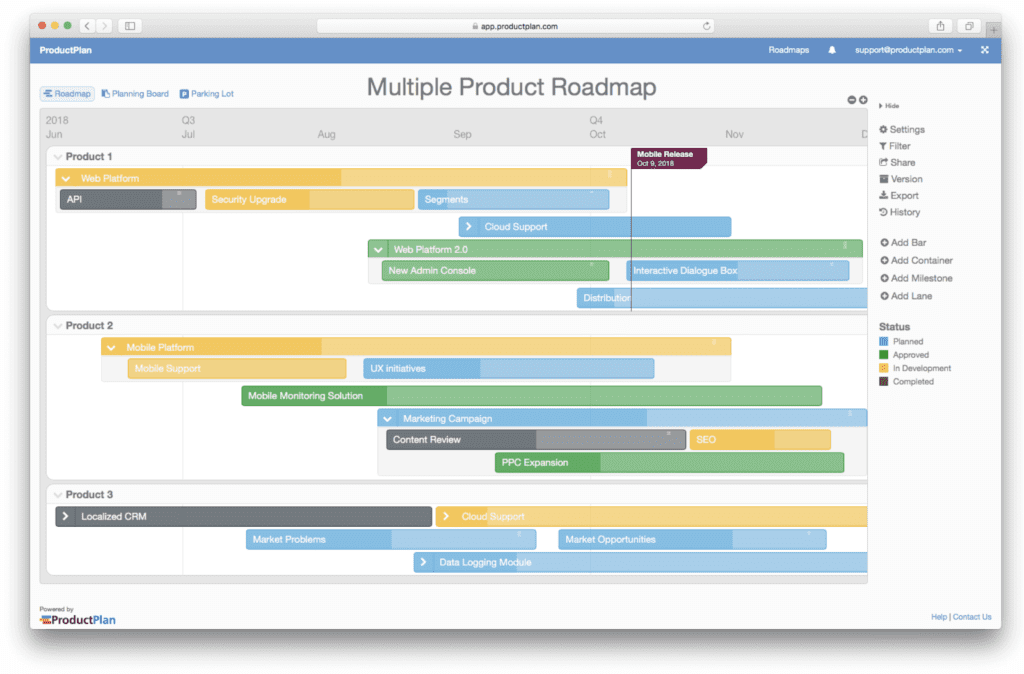When we talk about creating a roadmap, we are almost always describing a roadmap representing one product. But there are times when you will want a multiple product roadmap, which communicates the plans for several separate products.
In this article, we will discuss under what circumstances your team should use a multiple product roadmap. We’ll also offer some tips for developing this type of roadmap effectively.

Why Would an Organization want a Multiple Product Roadmap?
There are several reasons it would make sense for a product team to use a single roadmap to represent more than one product. Here are a few examples:
- One PM in your company handles multiple products. Imagine you’re a product manager overseeing several products at the same time. With a multiple product roadmap, you have an at-a-glance view of the high-level plans and progress of all your products.
- Your development teams need to coordinate efforts across multiple products. Let’s say you have engineers, QA testers, UX/UI designers, and other teams who are working on several products. If you create a multiple product roadmap, you can quickly view the workload and plans for each team across all products. This can help with planning and resource allocation.
- You want to maintain a consistent strategic plan across multiple products. It can also help you with strategic planning and tracking business objectives across all of your products. Again, assuming you’re using the right native roadmap app, you can tie each epic or theme of each product on your roadmap to a specific business goal. You can then view all initiatives on your roadmap (across all products) according to specific types of goals.
Your Multiple Product Roadmap: Tips for Success
1. Keep the roadmap high-level.
All product roadmaps should be high-level. But a roadmap covering several products is even more likely to become cluttered and confusing than one representing only one product.
Make sure to include on your multiple product roadmap only the most strategic initiatives for each product.
2. Use the right roadmap tool.
With a multiple product roadmap, you are often going to need to shift among various roadmap views. When you meet with your development team, you will review that team’s workload, goals, and timelines across all products. When you’re presenting the roadmap to your executives, present a strategic-objective view to show them how you anticipate your planned work across all products will contribute towards business goals.
3. Group products on your roadmap strategically.
The point of using a multiple product roadmap is to help you more effectively organize, monitor, and communicate the strategic plans of each product represented on that roadmap.
You don’t want to cram several products onto a single roadmap to save space, or to save time opening and closing more than one roadmap. For example, you might not want to place two products on the same roadmap if those products target entirely different markets or have different success metrics.
To get the full value, you’ll want to make sure you are grouping products that share strategic business goals and plans.
4. Present the correct view to each stakeholder audience.
It always helps to tailor your roadmap presentation to your specific audience. But this strategy becomes even more critical when you’re presenting a multiple product roadmap; the more details, the more opportunities there are to create confusion.
If you are presenting your multiple product roadmap to your sales team, for example, you want to present a high-level view of how each initiative can help them sell more. You would not want to show your sales reps a breakout of your planned development resources and team workloads.
If you are meeting with your marketing team to begin planning a campaign around the launch of a specific product, you will want to be able to focus on just that product. In this meeting, you will also want the ability to switch views quickly within that product’s details. Your marketing team might want to see your proposed development timeframe (to help with their campaign planning). They might also want to see your strategic objectives for the product’s planned functionality (to give them an idea of the key messaging for the campaign itself).
The need for this type of flexibility—allowing you to show many different views of the same roadmap—is another reason you should use the right native roadmap app, instead of spreadsheets or presentation software.
5. Set clear success metrics for every initiative on your roadmap.
Whether your roadmap summarizes the strategic plans for one product or several, you will want to tie each theme, epic, or other initiatives to a clearly defined and quantifiable success metric.
This could include using the Objectives and Key Results (OKRs) framework used by Intel and Google, and/or the Key Performance Indicator (KPI) approach.
When you’ve assigned to every item on your roadmap an objective way to measure its success, you will have the feedback you need to know when it is time to adjust your priorities and resources. Maybe a feature is not meeting your targeted goal for it, and the data suggests you should move resources away from continued work on that feature in favor of a better-performing initiative. Or perhaps an area of product functionality is winning over new customers at a higher rate than you’d hoped, and that suggests it is worth allocating even more resources to improving that functionality.
Having a one-roadmap view of the status of all these success metrics can help you quickly and effectively move resources and priorities to wherever—on whichever product—they can have the most positive impact on.






